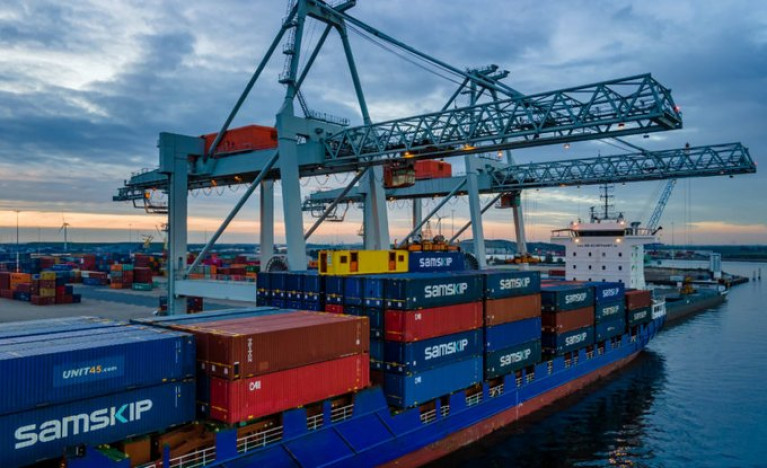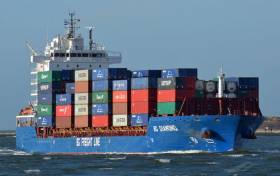Displaying items by tag: New LoLo route
Samskip's New Dublin-Amsterdam Container Service Brings Irish Business to European Hinterland
In addition to the recent dramatic boost in direct ferry routes to mainland Europe, Samskip is ramping up its shortsea container services by introducing today an additional dedicated link connecting Amsterdam and Dublin Port.
The weekly connection will mean Irish imports can avoid post-Brexit hassles applying to goods received via UK-based distributors, while exports will benefit from greater reach into EU markets in the northern Netherlands, Germany and beyond.
Launching of the fixed day service involves a departure from the TMA Terminal Amsterdam today (Monday evenings) for an arrival in Dublin on Wednesday and a weekend return to the Dutch port. This complements Samskip’s existing Rotterdam-Ireland shortsea services by offering rail, barge and road customers in the Netherlands a new Monday night departure to Ireland.
Thijs Goumans, Head of Ireland Trade, Samskip, said that the service launch came at a time when importers and exporters in Ireland-mainland Europe trades continue to weigh up options as the consequences of Brexit for supply chain management became clear.
“The Ireland-North Continent freight market is in a dynamic phase, and fixed day container services to/from Amsterdam provide the certainty on which supply chain managers serving the Dutch and German markets can base business growth,” he said. Subject to initial moves, Samskip would consider calls to connect other ports in Ireland to Amsterdam direct.
“Shortsea container services can once more prove themselves more than a match for ro-ro, particularly for products previously shipped to distributors in the UK then redistributed across the Irish Sea,” said Richard Archer, Regional Director, Samskip Multimodal. “Amsterdam is a high-performance port connecting straight into the hinterland area and the entire Samskip Ireland team is delighted by this new commitment to pan-European transport.”
Koen Overtoom, CEO Port of Amsterdam, commented: “We are very pleased with this expansion of the port’s short sea network. It underlines the strength of the services Samskip and TMA Logistics offer, as well as our strategic position. Ireland is a key market, and in these rapidly changing times a direct link presents tremendous opportunities. We will continue to work with TMA, Samskip and international partners to make this service a lasting success.”
Michael van Toledo, General Manager TMA Amsterdam, said Samskip’s rail links to Duisburg and TMA’s congestion-free road access offered a platform for growth in FMCG volumes into Ireland and pharma and dairy exports moving the other way. “The service could have been custom-made for our ambitions to grow Amsterdam as a hub for shortsea container business,” he said. “It targets the greater appetite for direct North Continent services to Ireland post-Brexit, with TMA’s cross-docking winning over trailer operators in markets further south.”
Afloat add that Samskip operate existing direct container routes to Irish Ports linking Rotterdam involving Dublin, Waterford, Cork in addition a service to Belfast.
As mentioned in the photo-caption, the Irish links with the Dutch operator also include Iceland where the company had its origins dating to 1990. In the following decade Samskip acquired a former Aran Islands ferry, Oileáin Árann which served notably as the final passenger/cargoship based out of Galway, until sold to Samskip and renamed Sæfari.
Shipping Company to Offer New Route from Port of Waterford
A shipping line based in the Netherlands, reports The Irish Times, will open up Waterford port to new international trade routes when it commences a weekly service on the Waterford to Rotterdam route which will act as a deep-sea feeder for Irish importers and exporters.
The Dutch operator BG Freight Line, in partnership with global shipping giant Maersk, is to commence the service on July 6th to support industry in the southeast. Effectively the move will allow goods travelling from Waterford to continue through Rotterdam to other ports such as Shanghai, whereas previously goods for destinations beyond Europe would typically have shipped from Dublin.
Part of the Peel Ports Group, BG Freight Line runs a fleet of 23 containerised vessels from its headquarters in the Netherlands. Maersk, meanwhile, is the largest container logistics organisation in the world, moving more than 12 million containers a year.
BG Freight Line chief executive Koert Luitwieler said the addition of Waterford to its network would strengthen the company’s Irish Sea network which encompassed routes from Dublin and Cork at present.
For more on this new additional Ireland-mainland Europe lo-lo service click here
























